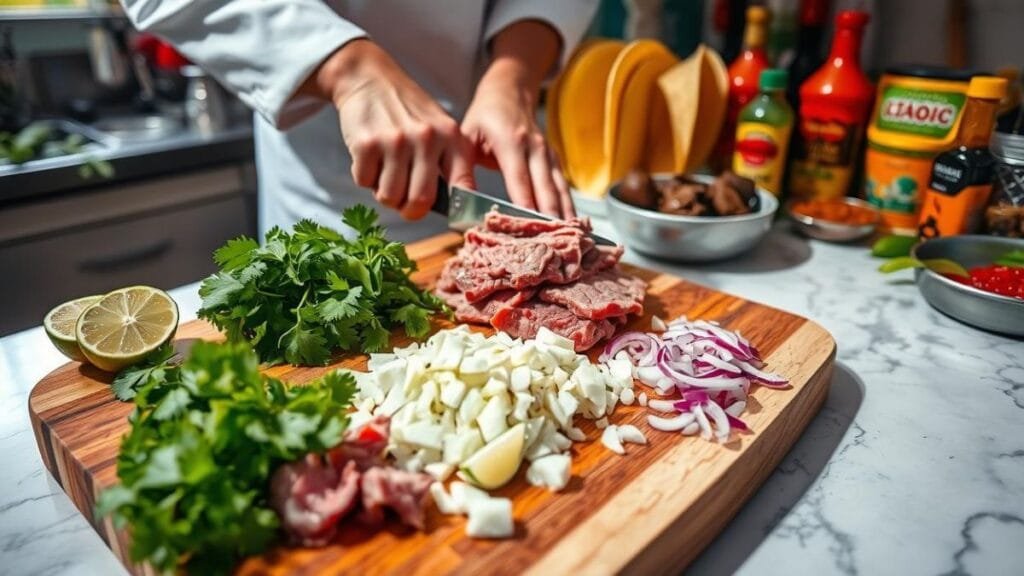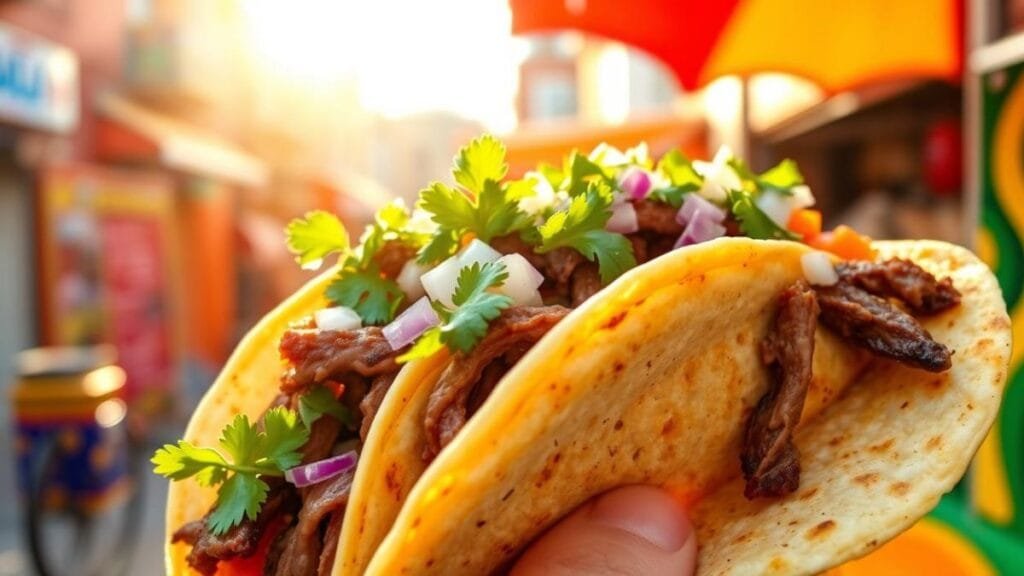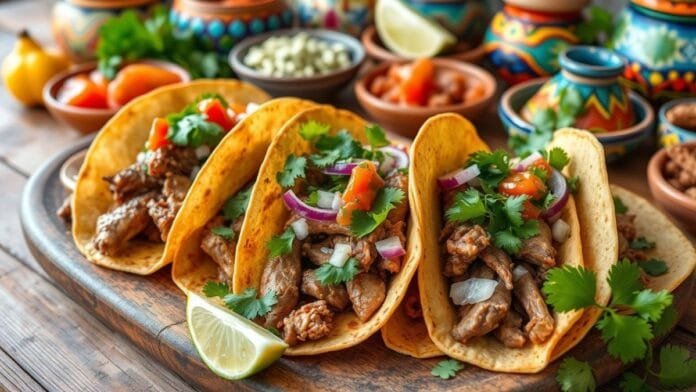Did you know that making beef tongue tacos takes about 3 hours? It turns tough meat into a delicious treat. My exploration of Mexican food showed me the amazing world of tacos de lengua. It’s a street food that truly captures the heart of real cooking traditions.
Tacos de lengua are more than food; they celebrate Mexican cooking’s creativity. This recipe turns an unusual ingredient into a soft, tasty dish that amazes food lovers.
Authentic taco recipes make simple ingredients shine. With just 10 essential ingredients, these tacos take you to Mexico’s lively streets. Every bite shares a tale of creativity and pride in culture.
Tacos de lengua are loved in taco trucks and home kitchens alike. They challenge old ideas and encourage people to try new flavors. Using corn or flour tortillas, slow cooking makes the beef tongue incredibly tender.
I invite you to join me on this food adventure. We’ll learn how to make the most tender, flavorful beef tongue tacos. They’ll surely impress even the pickiest eaters.
The Cultural Significance of Mexican Offal Cuisine
Traditional Mexican dishes celebrate the art of using every part of the animal. This turns what others might see as less desirable into amazing dishes. Offal tacos show the resourcefulness and creativity of Mexican culture.
From Street Food to Cultural Icon
Beef tongue tacos have grown from simple street food to a beloved dish. In Los Angeles, immigrant groups keep these dishes alive. They offer flavors that go beyond what most people know.
- Beef tongue is full of B vitamins and minerals
- Common offal tacos include lengua, cabeza, and tripas
- Places like Tacos Al Vapor El Canelo serve authentic versions
The Heritage of Nose-to-Tail Eating
Using every part of the animal shows respect for food and the environment. While American food focused on prime cuts, Mexican cuisine celebrated organ meats. This tradition has lasted for decades.
Regional Variations Across Mexico
Every Mexican region adds its own twist to offal tacos. From big cities to small towns, the way they make and season beef tongue tacos is different. This variety celebrates local ingredients and cooking styles.
| Region | Unique Preparation | Key Seasonings |
|---|---|---|
| Mexico City | Slow-cooked tongue | Garlic, bay leaves |
| Jalisco | Crispy pan-fried | Onions, pepper |
| Oaxaca | Marinated style | Chili, cumin |
The Art of Preparing Tacos de Lengua
Making tacos de lengua is a skill that takes patience and knowledge of Mexican cooking. This recipe turns beef tongue into a delicious dish that’s a true taste of Mexican street food.
Essential Ingredients and Equipment
First, you’ll need these important ingredients:
- 1 beef tongue (3-4 lbs)
- 1 large onion
- 4-5 garlic cloves
- 2-3 hojas de laurel
- 3-4 cucharadas de aceite
- Sea salt and black pepper
Step-by-Step Cooking Process
I’ve learned how to make tender, tasty tacos de lengua over the years. Here’s how I do it:
- Rinse the beef tongue well
- Put it in a big pot with onions, garlic, and laurel leaves
- Cover it with water and simmer for 3-4 hours
- Take out the tongue and let it cool a bit
- Peel off the outer skin
- Cut it into thin slices
- Fry in hot oil
Tips for Achieving Perfect Tenderness
Getting the meat to be tender is an art. The secret is cooking it slowly. Using a crockpot helps a lot. Make sure to check the meat often – it should be so tender it shreds easily.
Pro tip: Cut the beef tongue into small, uniform pieces before frying. This ensures even cooking and a consistent texture in your tacos.
| Nutritional Content | Per Taco |
|---|---|
| Calories | 196 |
| Protein | 10g |
| Fat | 10g |
| Carbohydrates | 16g |
This recipe makes about 20 tacos. It’s great for sharing with those who love authentic Mexican food.

Flavor Profile and Texture Experience
Tacos de lengua take you on a unique culinary journey. They offer a flavor that elevates spicy taco fillings to a gourmet level. The tongue meat is incredibly tender, making each bite a delight.
The nutritional value of tacos de lengua is impressive. Each serving gives you:
- 25 grams of high-quality protein
- Significant amounts of vitamin B12
- Essential minerals like iron, zinc, and selenium
- Approximately 15 grams of fat
The texture of tacos de lengua is truly exceptional. When cooked right, the meat becomes soft and delicate. It’s a culinary magic that turns tough meat into a soft, flavorful treat.
| Flavor Characteristic | Description |
|---|---|
| Taste Profile | Mild, slightly gamey with subtle meat flavors |
| Texture | Tender, soft, smooth |
| Cooking Method Impact | Slow cooking creates maximum tenderness |
Across Mexico, different regions have their own twist on tacos de lengua. But the essence remains the same. Whether from street vendors or fancy restaurants, this dish celebrates the art of nose-to-tail eating with elegance.
Perfect Toppings and Accompaniments for Authentic Taste
Making the best tacos de lengua is more than just cooking the meat. The right toppings and sides can turn a good taco into a memorable meal. I’ll show you how to pick the best ingredients to make your Taco Tuesday specials stand out.
Traditional Salsa Verde Recipe
A classic salsa verde is key to authentic tacos de lengua. Here’s my favorite recipe that adds a burst of flavor to every bite:
- 6-7 tomatillos, husked and rinsed
- 1 white onion
- 2-3 jalapeño peppers
- Fresh cilantro leaves
- Lime juice
- Salt to taste
Fresh Garnishes and Condiments
The right garnishes can make your tacos de maíz truly special. I suggest these classic toppings:
- Finely chopped fresh cilantro
- Diced white onions
- Sliced radishes
- Lime wedges
- Crumbled queso fresco
Choosing the Right Tortillas
For authentic tacos de lengua, corn tortillas are essential. Always use fresh tortillas de maíz, warmed on a griddle to enhance their corn flavor. When preparing for Taco Tuesday, warming your tortillas properly is key.
Pro tip: Double up your tortillas to prevent breaking and to add extra texture to your tacos. The goal is to have tender tongue meat, crisp garnishes, and warm, soft tortillas.

Conclusion
Exploring authentic taco recipes has shown us the amazing world of Mexican cuisine. Tacos de lengua are more than food; they invite us to dive into tradition, skill, and taste. They turn beef tongue, once overlooked, into a celebrated dish, showing Mexican cooking’s creativity.
Making these tacos takes patience and love. Cooking the 2-3 lb beef tongue for 2.5 to 3 hours makes it tender and rich. The steps of simmering, skinning, and shredding highlight the art of authentic tacos in Mexican cuisine.
Lengua tacos are special because they connect different culinary traditions. They go from Mexico’s street food to tables worldwide, inviting people to try new flavors. The mix of corn tortillas, fresh cilantro, diced tomatoes, and seasoned beef tongue offers a unique taste experience.
In the end, tacos de lengua are a journey that celebrates innovation and respect for food. Each bite shares a story of technique, flavor, and cultural pride. It inspires food lovers everywhere.
Tacos de Lengua FAQ
What exactly are tacos de lengua?
Tacos de lengua are traditional Mexican tacos made from slow-cooked beef tongue. The tongue is simmered until tender, then sliced or chopped. They’re served on warm corn tortillas with fresh toppings like salsa verde, cilantro, and onions. It’s a delicacy that turns an often-overlooked cut of meat into a delicious and authentic Mexican dish.
Is beef tongue tough to prepare at home?
Preparing tacos de lengua is actually quite straightforward. The key is slow cooking the beef tongue for about 3 hours until it becomes fork-tender. I recommend using a large pot or crockpot, simmering the tongue with onions, garlic, and spices. Once cooked, the outer layer is easily removed, and the meat can be sliced or chopped for tacos.
What does beef tongue taste like?
The flavor of beef tongue is surprisingly mild and delicate. It’s often compared to pot roast but with a more refined texture. When properly prepared, it’s incredibly tender and melts in your mouth. Its subtle taste makes it an excellent canvas for bold Mexican seasonings and toppings.
Are tacos de lengua considered a street food or a gourmet dish?
Tacos de lengua originated as a traditional street food in Mexico. They have evolved to be appreciated in both casual and more upscale culinary settings. They represent a nose-to-tail eating approach that’s deeply rooted in Mexican culinary culture. This showcases the resourcefulness and creativity of Mexican cuisine.
What are the best toppings for tacos de lengua?
Traditional toppings include fresh salsa verde, chopped cilantro, diced onions, and lime wedges. Some people also enjoy adding avocado, sour cream, or hot sauce. The key is to use fresh, authentic ingredients that complement the tender beef tongue. Corn tortillas are essential for the most traditional experience.
Is beef tongue a healthy meat option?
Beef tongue is surprisingly nutritious. It’s rich in protein, contains essential vitamins and minerals, and is relatively low in fat when prepared without excess oil. It’s a good source of zinc, iron, and B vitamins. Like all organ meats, it should be consumed in moderation as part of a balanced diet.
How long can I store prepared tacos de lengua?
Cooked beef tongue can be stored in an airtight container in the refrigerator for 3-4 days. To reheat, gently warm the meat in a skillet to maintain its tenderness. For best flavor and texture, I recommend consuming the tacos within two days of preparation.
Can I make tacos de lengua if I’m not experienced in Mexican cooking?
Absolutely! While the dish might seem complex, it’s quite approachable for home cooks. The process is mostly about patience during the slow cooking. With a good recipe and some basic cooking skills, you can successfully prepare delicious tacos de lengua at home. Don’t be intimidated – it’s a great way to explore authentic Mexican cuisine.















Hi I all the time used to read article in news papers but now as I am a user of net thus from now I am using net for content, thanks